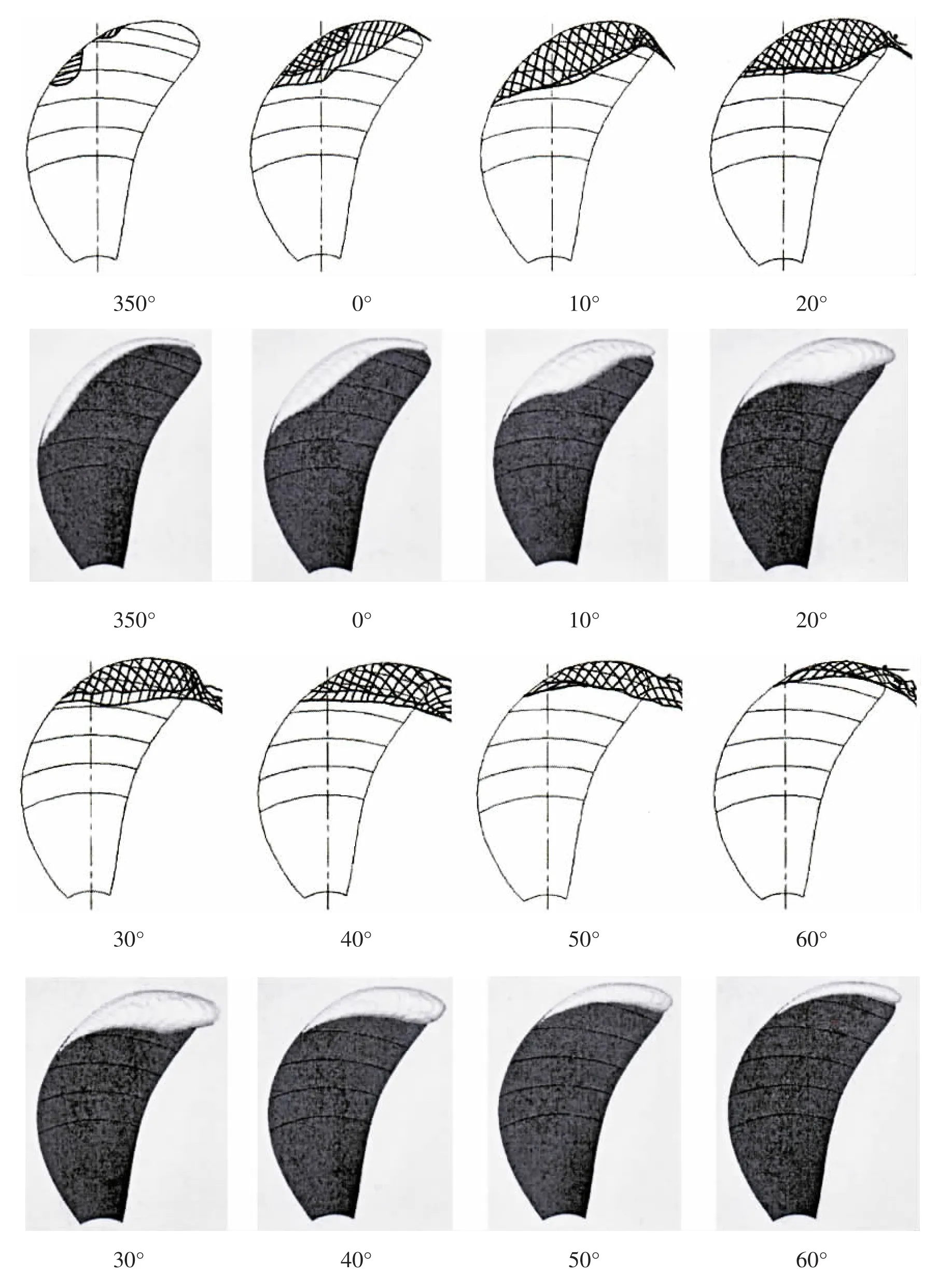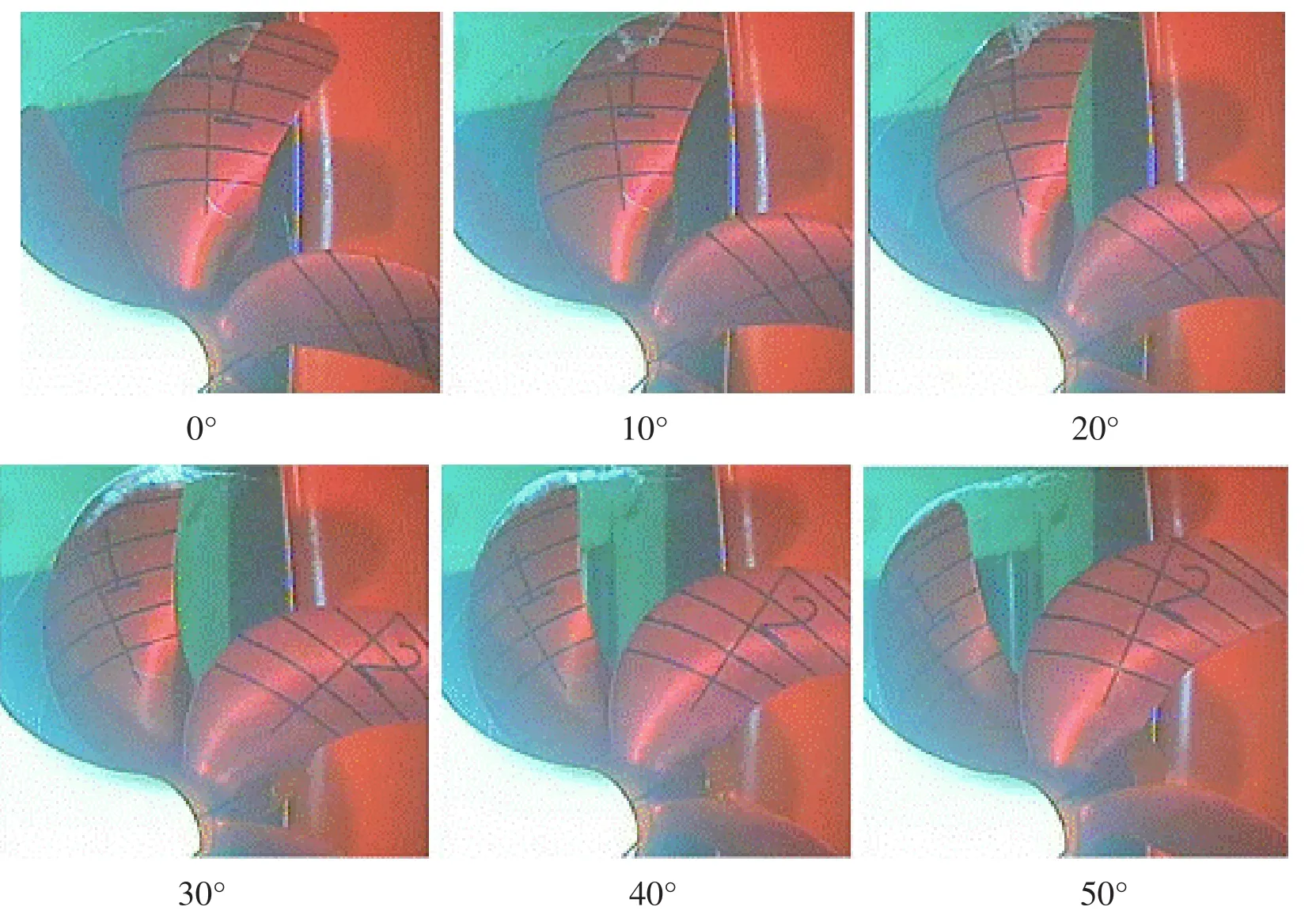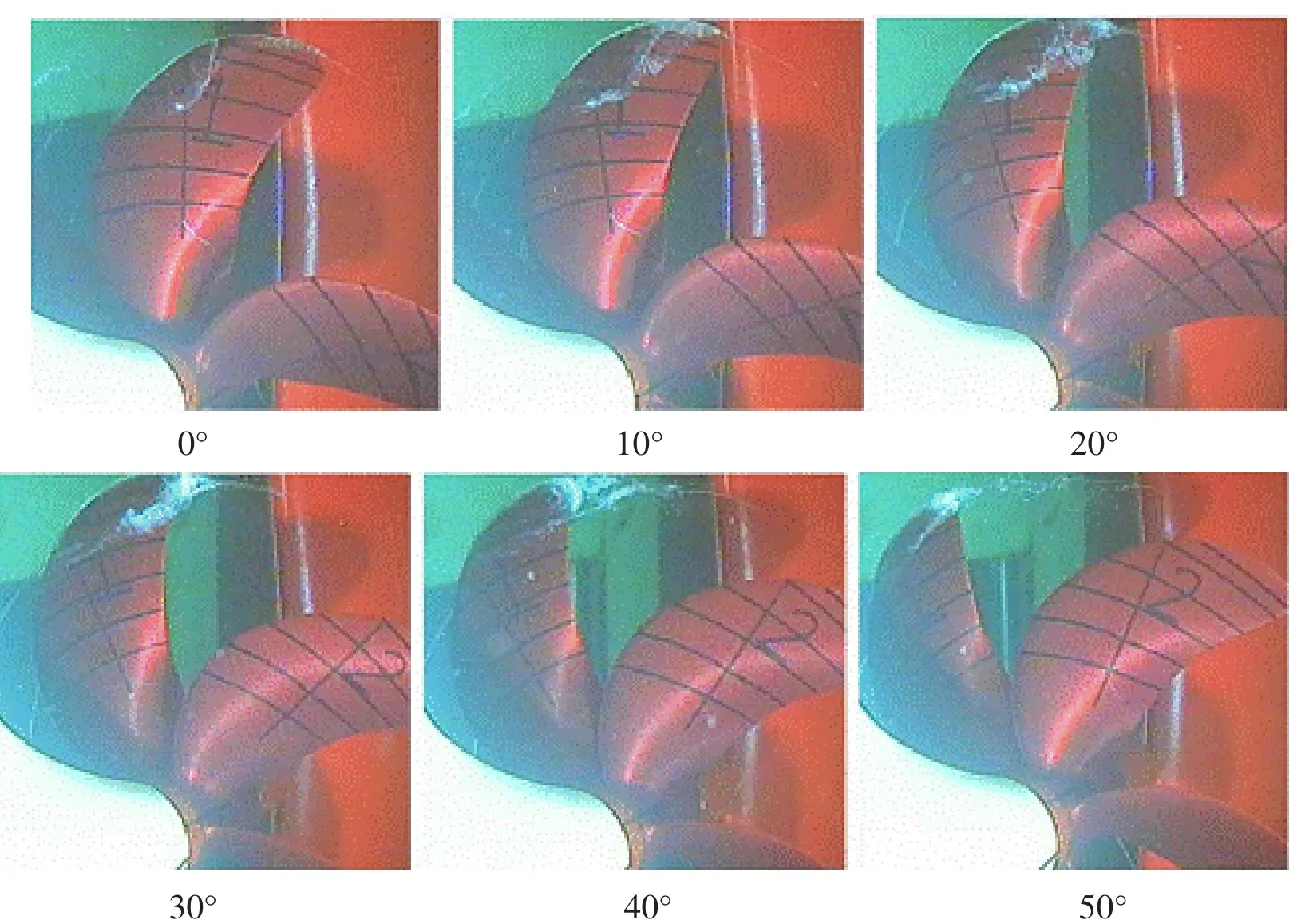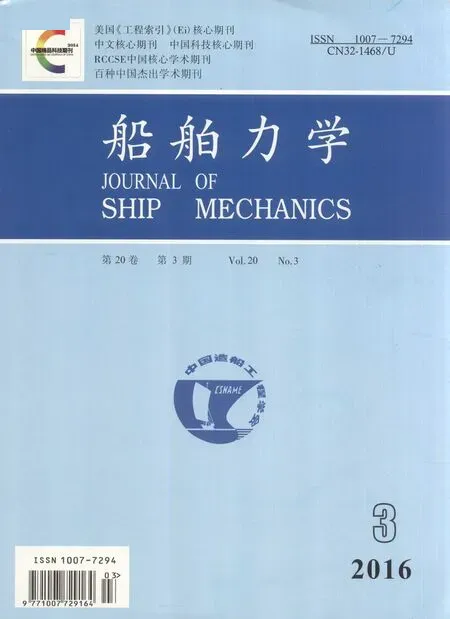Numerical Predictions of the Propeller Cavitation behind Ship and Comparison with Experiment
,
(a.National Key Laboratory on Ship Vibration&Noise;b.Jiangsu Key Laboratory of Green Ship Technology, China Ship Scientific Research Center,Wuxi 214082,China)
Numerical Predictions of the Propeller Cavitation behind Ship and Comparison with Experiment
LIU Deng-chenga,b,ZHOU Wei-xina,b
(a.National Key Laboratory on Ship Vibration&Noise;b.Jiangsu Key Laboratory of Green Ship Technology, China Ship Scientific Research Center,Wuxi 214082,China)
The effects of turbulence model on propeller cavitation simulation results are presented.It shows that the common turbulence model can deal well with the propeller cavitaion shapes.And then the propeller cavitation performance behind ship was numerically simulated using a hextetrahedral mesh based on RANS solver,the Suaer’s cavitation model based on transport equation and a SSTk-ω turbulence model were coupled in the RANS solver.A symmetry boundary condition is applied on the top of computational domain instead of the free surface,which is similar to a tunnel’s wall. To observe the cavitation pattern during the revolution of propeller,the propeller is rotated with a constant rotation angle of 1.0 degree using a sliding mesh technique.Cavitation patterns of the simulations are compared with the experimental results carried out in Large Cavitation Channel of CSSRC (LCC).Although the predicted propeller tip vortex cavity is missing because of the mesh resolution,the predicted dynamic cavitation behaviors generally well agree with experimental observation.
cavitation;propeller;ship;numerical prediction
0 Introduction
The propeller cavitation can rise up the vibration,the noise and the erosion.Therefore, the predicted propeller dynamic cavitation behavior is of great interest for propeller designer.
Cavitation presents complex unsteady,turbulent and multi-phase flow phenomena with a large density difference and mass transfer.These features result in a unique challenge for the simulation of cavitating flows.
The simulations of cavitating flow using viscous CFD method were performed actively in the last decade because cavitation models and computation power have been rapidly developed.Many researchers did some simulations of foil and propeller cavitating flow.For example,Rhee and Kawamura[1]studied the cavitating flow around a marine propeller using an unstructured mesh.Liu[2-4]simulated the cavitation performance of marine propeller using a hybrid mesh based on RANS solver using singhal model.Coutier-Delgosha et al[5]computedcavitating flows around 2D foil by modifying turbulence model,and the sheet cavity length and the dynamic shedding behaviour were very similar to those observed in the experiment.Li[6-7]predicted unsteady cavitating flows of 2D NACA0015 foil and 3D twisted foil using the same idea.Shin et al[8]carried out cavitation simulation on conventional and high-skewed propellers in the Behind-Hull Condition.Paik et al[9]simulated the cavitation and hull pressure fluctuation for propeller with hull interaction,and so on.
In this paper,the effects of turbulence model on propeller cavitation simulation results are researched.And then the propeller cavitation performance behind ship was numerically simulated using a hextetrahedral mesh based on RANS solver,the Suaer’s cavitation model based on transport equation and a SST k-ω turbulence model were coupled in the RANS solver.
1 Numerical method
1.1 Governing equations
For the multi-phase flow solutions,the single-fluid mixture model is employed.The governing equations are written for the mass and momentum conservation of mixed fluid as follows:

where ρmis the mixed density,μ is the mixed viscosity,μtis the mixed eddy viscosity which is calculated by turbulence model.
Convection terms are discretized using a second order accurate upwind scheme,while diffusion terms are discretized using a second order accurate central differencing scheme.A segregated solver with SIMPLE as the velocity-pressure coupling algorithm was selected.The discrete equations are solved using Gauss-Seidel iterations,and algebraic multi-grid method accelerates the solution convergence.The effect of gravity is neglected.The double model is used for dealing with free-surface.
1.2 Sauer cavitation model
The mixed density is controlled by vapor fraction α:

The vapor transport equation is written as:

where ρvand ρlare the density of vapor and liquid,respectively.andare the rates of vapor generation and condensation,respectively.Sauer derived the expressions ofand

where ρvis saturated vapor pressure.
2 The effect of turbulence model
For research the effect of different turbulence model,three different turbulence models are employed to research the effect of different turbulence model which include k-ε,SST k-ω and Reynolds stress turbulence model(RSM).The PPTC propeller cavitation in uniform flow is carried out.PPTC propeller is an international standard model which is proposed on the first workshop on cavitation and propeller performance.There are abundant experimental data.
Tab.1 presents the case of computational.The expressions of advance ratio and cavitation number are written as follows:


Tab.1 The case2-1 of cavitation computational
For tip vortex region grid refinement,a block was created according to the helix line,and the pitch is equal to the propeller pitch at the 1.0 time radius(see Fig.1).The textetrahedral mesh is used(see Fig.2).

Fig.1 The block for tip vortex region grid refinement

Fig.2 The grid types

Fig.3 The computational cavity shapes and compared with experimental
Fig.3 presents the comparison of the computed cavity shapes with the experimental results which come from Potsdam Model Basin at the first workshop on cavitation and propeller performance.The computed cavity shapes can be confirmed by the iso-surface of vapor volume fraction of 0.1.From the experimental results we clearly see that the cavitation is to occur in the tip,root and leading edge of suction side of propeller.Fig.4 shows that the all computational cases catch the cavity in the tip,root and leading edge,but the sheet cavitation at leading edge is a little unpredicted.The computational results indicated that the common turbulence model can deal well with cavitating flow,and the SST k-ω turbulence model is chosen for simulating the propeller cavitation behind ship because this turbulence model is often imposed in propeller performance simulation.
3 Propeller cavitations behind ship
3.1 Geometry and computational domain
An 82000DWT bulk carrier with five blades propeller was chosen for the cavitation simulation which has experimental data of cavitation observation come from LCC of CSSRC.Propeller model is a five bladed propeller with diameter D=0.237 m and area ratio of 0.52.
The computational domain was created:The inlet of the domain is at 1.5L upstream of the ship hull;exit at 2.5L downstream;outer boundary at 1.5L from the center of symmetrical plane; L is the length of ship.
3.2 Computation mesh and conditions
The entire domain is filled with hextetrahedral mesh.The minimum size of grid is 1.8 mm in the ship stern region and 0.5 mm in the propeller tip region(see Fig.4),there are only about 2~4 grids in the propeller tip vortex region because of the size of propeller model tip vortex cavitation is about 1~2 mm,so the propeller tip vortex cavitation will be missing.The grid cells number was about 3.2 million in static region and 0.8 million in rotating region.
Boundary conditions were set to simulate the flow around ship with propeller:on the inlet boundary and the outer boundary,velocity components of uniform stream with the given inflow speeds were imposed;on wall surface,the no slip condition was imposed;and on thesymmetrical plane boundaries of free-surface,symmetry was ensured;on the exit boundary, the static pressure was set to a constant value according to the cavitation index.The unsteady wetted computation results are used as the initial value of unsteady cavitation simulation.The propeller is rotated with a constant rotation angle of 1.0°using a sliding mesh technique.The conditions are described in Tab.2.The expression of cavitation index is written as follows:


Fig.4 The mesh of ship stern surface

Tab.2 The computational conditions
3.2 Results and comparison with experiment
The simulations of propeller cavitating flow with ship are calculated at two conditions. The computed results of thrust coefficient are summarized in Tab.3.The results of model test are also presented at wetted condition.For the wetted simulation,the comparison shows quite good agreement,and the thrust coefficients are over predicted 4.34%and 1.73%at design and ballast condition,respectively.The simulated results show that the thrust coefficient will be slightly increased less than 1%when propeller comes into cavitation at design and ballast condition.
Cavitation patterns at some propeller blade angle at the design and ballast draught conditions are compared with the experimental results in Figs.5 and 6,respectively.The iso-surface of vapor volume fraction at value 0.1 shows the interface of cavity.The tip vortex cavitation in simulation results is missing which is consistent with expected,but the cavity patterns generally well agree with the experiments.At the design and ballast draught condition,the leading edge cavitation from 0.7R to 0.95R of the propeller blade at propeller blade angle of 350° is appeared in the numerical simulation,while the patch cavitation is observed in model test.

Tab.3 The thrust coefficient at two conditions

Fig.5 The comparison of cavitation patterns at design draught condition

Fig.6 The comparison of cavitation patterns at ballast draught condition
Fig.7 and Fig.8 show the cavitation photos at design and ballast draught condition.At the two draught conditions,the cavitation presents unstable behavior at some propeller blade angle of 20°and 30°,especially at the ballast draught condition,but the simulation results are stable at all blade angles.The simulations results can present the cavitation dynamic behavior withblade angles,not present the cavitation dynamic behavior with time at the same blade angle.

Fig.7 Cavtation photos at design draught condition

Fig.8 Cavtation photos at ballast draught condition
4 Conclusions
Firstly,the effects of turbulence model on propeller cavitation simulation results are pre-sented.It shows that the common turbulence model can deal well with the propeller cavitaion shapes.And then the propeller cavitation performance behind ship was numerically simulated using a hextetrahedral mesh based on RANS solver,the Suaer’s cavitation model based on transport equation and a SST k-ω turbulence model were coupled in the RANS solver.And the simulation results were compared with the experimental results performed in the large cavitation channel.
The simulated results show that the thrust coefficient will be slightly increased less than 1%when propeller comes into cavitation at design and ballast condition.The cavitation patterns of simulations results can present the cavitation dynamic behavior with blade angles,not present the cavitation dynamic behavior with time at the same blade angle.Although the predicted propeller tip vortex cavity is missing because of the mesh resolution,the predicted dynamic cavitation behaviors generally well agree with experimental observation.We believe that numerical assessment cavitation pressure fluctuation is tangible in the near future.
For the further work,simulations of hull pressure fluctuation for a marine propeller operating behind a hull will be simulated.
[1]Shin Hyung Rhee,Takarumi Kawamura.A study of propeller cavitation using a RANS CFD method[C]//The 8th International Conference on Numerical Ship Hydrodynamics,September 22-25,2003.Busan,Korea,2003.
[2]Liu Dengcheng,Hong Fangwen,Zhao Feng,Zhang Zhirong.The CFD analysis of propeller sheet cavitation[C]//Proceedings of the 8th International Conference on Hydrodynamics,September 30-October 3,2008.Nantes France,2008.
[3]Liu Dengcheng,Hong Fangwen.The Numerical Predicted of SMP11 propeller performance with and without cavitation[C]// Second International Symposium on Marine Propulsors,SMP’11,June,2011.Hamburg,Germany,2011.
[4]Liu Dengcheng.The numerical predicted of VP1304 propeller cavitation performance in oblique flow[C]//Fourth International Symposium on Marine Propulsors.smp’15,May 31-June 4,2015.Workshop:Propeller performance.Austin,USA, 2015.
[5]Coutier-Delgosha O,Fortes-Patella R,Reboud L.Evaluation of the turbulence model influence on the numerical simulations of unsteady cavitation[J].Journal of Fluids Engineering,2003,125(1):38-45.
[6]Li D Q,Grekula.Prediction of dynamic shedding of cloud cavitation on a 3D twisted foil and comparison with experiments [C]//27th Symposium on Naval Hydrodynamics.Oct.5-10,2008.Seoul,Korea,2008.
[7]Li Daqing,Mikael Grekula,Per Lindell.A modified SST k-ω turbulence model to predict the steady and unsteady sheet cavitation on 2D and 3D hydrofoils[C]//Proceedings of the 7th International Symposium on Cavitation.CAV2009.Auguset 17-22,Ann Arbor,Michigan,USA,2009.
[8]Shin K W,Anderson P,Mikkelsen R.Cavitation simulation on conventional and high skewed propellers in the behindhull condition[C]//Second International Symposium on Marine Propulsors.SMP’11,June,2011.Hamburg,Germany, 2011.
[9]Kwang-Jun Paik,Hyumg-Gil Paik,Jongsoo Seo.URANAS simulations of cavitation and hull pressure fluctuation for marine propeller with hull interaction[C]//Third International Symposium on Marine Propulsors,smp’13.May,2013.Launcestpm,Tas,amoa,Australia,2013.
船后螺旋桨空泡数值预报及试验对比
刘登成a,b,周伟新a,b
(中国船舶科学研究中心 a.船舶振动噪声重点实验室;b.江苏省绿色船舶技术重点实验室,江苏 无锡 21408)
文章研究了湍流模型对螺旋桨空泡计算结果的影响,结果表明常用的湍流模型均可较好地预报螺旋桨空泡形态。采用RANS求解器,结合SST k-ω湍流模型和Sauer空化模型,数值模拟了船后螺旋桨空泡。用对称面边界条件处理自由表面,滑移网格技术处理螺旋桨旋转,时间步长为1°。螺旋桨空泡模拟结果与大型循环水槽试验结果进行了对比,虽然由于计算网格稀疏的原因没能捕捉到螺旋桨梢涡空泡,但螺旋桨空泡随空间角度的动态行为与试验观察结果吻合较好。
空泡;螺旋桨;船体;数值预报
U661.73
:A
刘登成(1982-),男,中国船舶科学研究中心高级工程师;
U661.73
:A
10.3969/j.issn.1007-7294.2016.03.001
1007-7294(2016)03-0233-10
周伟新(1970-),男,中国船舶科学研究中心研究员。
Received date:2015-12-03
Foundation item:Supported by the National Natural Science Foundation of China(Grant No.11332009)
Biography:Liu Deng-cheng(1982-),male,senior engineer,E-mail:edon_001@163.com;
ZHOU Wei-xin(1970-),male,researcher.
- 船舶力学的其它文章
- Establishment of Metamodels for Ship Seakeeping Performance Using an Effective Approximation Modeling Method
- Influence of Added Wave Resistance Calculation Methods on Ship Speed in Seas
- A Comparison of Positioning Capabilities between Vessels with Different Thruster Configurations
- Numerical and Experimental Investigation of the Problem of Diving Difficulty of Autonomous Underwater Vehicle
- Numerical Prediction and Experimental Measurement on Truss Spar Motion and Mooring Tension in Regular Waves
- A Combination Mooring System and Mooring Characteristics Study

